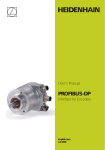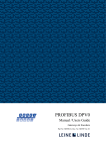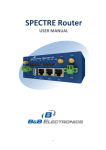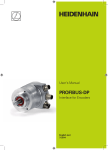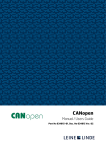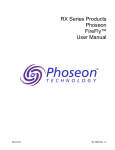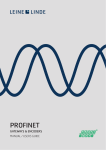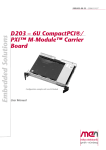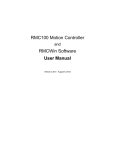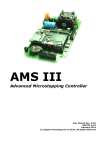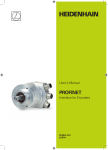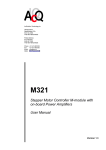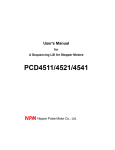Download profibus dp
Transcript
PROFIBUS DP Manual / Users Guide DPV0 & DPV2 Encoders Part No 634814-01, Doc. No 634814 Ver. 01 PROFIBUS USER MANUAL Leine & Linde AB Content LIST OF TABLES..................................................................................................................................3 LIST OF FIGURES................................................................................................................................4 1 GENERAL INFORMATION.............................................................................................................5 1.1 ABSOLUTE ENCODERS .....................................................................................................................5 1.2 PROFIBUS TECHNOLOGY ...............................................................................................................5 1.3 ABOUT LEINE & LINDE AB .............................................................................................................5 1.3.1 TECHNICAL AND COMMERCIAL SUPPORT ......................................................................................5 1.3.2 CERTIFICATION OF PROFIBUS PRODUCTS ...................................................................................6 1.4 REFERENCES ....................................................................................................................................6 1.4.1 ABBREVIATIONS ...........................................................................................................................6 2 ENCODER INSTALLATION............................................................................................................7 2.1 SETTINGS INSIDE THE ENCODER .......................................................................................................7 2.1.1 NODE ADDRESS ............................................................................................................................7 2.1.2 BUS TERMINATION ........................................................................................................................7 2.2 CONNECTING THE ENCODER ............................................................................................................8 2.2.1 POWER SUPPLY .............................................................................................................................8 2.2.1 BUS LINES ....................................................................................................................................8 2.3 SHIELDING PHILOSOPHY ..................................................................................................................9 2.4 GSD-FILES ......................................................................................................................................9 2.5 LED INDICATION ...........................................................................................................................10 3 PROFILE OVERVIEW....................................................................................................................11 3.1 DPV0 ENCODER CLASSES ..............................................................................................................11 3.2 DPV2 ENCODER CLASSES ..............................................................................................................12 4 ENCODER FUNCTIONALITY, DPV0 ..........................................................................................13 4.1 BASIC ENCODER FUNCTIONALITY ..................................................................................................13 4.2 PROFIBUS DATA TRANSFER PRINCIPLE ........................................................................................13 4.2.1 During parameterization (DDLM_Set_Prm mode) ...............................................................13 4.2.2 Normal operation (DDLM_Data-Exchange mode) ...............................................................13 4.3 CONFIGURATION, DPV0................................................................................................................13 4.4 PARAMETERIZATION, DPV0..........................................................................................................13 4.4.2 Class 2 functionality ..............................................................................................................14 4.4.3 Commissioning diagnostics ...................................................................................................15 4.4.4 Scaling function control.........................................................................................................15 4.4.5 Measuring units per revolution..............................................................................................15 4.4.6 Total measuring range (units) ...............................................................................................16 4.4.7 Velocity control......................................................................................................................17 4.5 DATA TRANSFER IN NORMAL OPERATION (DDLM_DATA_EXCHANGE)........................................18 4.5.1 Data exchange mode .............................................................................................................18 4.5.2 Preset function.......................................................................................................................19 4.6 DIAGNOSTICS ................................................................................................................................20 4.6.1 Diagnostic Header.................................................................................................................20 4.6.2 Alarms....................................................................................................................................21 4.6.3 Operating Status ....................................................................................................................21 4.6.4 Encoder type ..........................................................................................................................22 4.6.5 Singleturn resolution or measuring step................................................................................22 4.6.6 Number of Distinguishable Revolutions ................................................................................23 4.6.7 Additional Alarms..................................................................................................................23 4.6.8 Supported Alarms ..................................................................................................................24 4.6.9 Warnings................................................................................................................................24 4.6.10 Supported Warnings ............................................................................................................25 4.6.11 Profile Version.....................................................................................................................26 4.6.12 Software Version..................................................................................................................26 4.6.13 Operating Time....................................................................................................................26 Part Id: 634814-01 Document Id: 634814 Ver. 01 Publication date: 2008-02-05 2 PROFIBUS USER MANUAL Leine & Linde AB 4.6.14 Offset Value .........................................................................................................................27 4.6.15 Offset Value of the Encoder Manufacturer..........................................................................27 4.6.16 Scaling Parameters Settings ................................................................................................27 4.6.17 Encoder Serial Number .......................................................................................................28 5 ENCODER COMMISSIONING EXAMPLE, DPV0.....................................................................29 6 ENCODER FUNCTIONALITY, DPV2 ..........................................................................................31 6.1 ISOCHRONOUS OPERATION.............................................................................................................31 6.2 ACYCLIC DATA EXCHANGE ............................................................................................................32 6.2.1 PROFIdrive parameters ........................................................................................................32 6.2.2 Encoder specific parameters .................................................................................................32 6.2.3 I&M functions........................................................................................................................33 6.3 SLAVE TO SLAVE COMMUNICATION ...............................................................................................33 6.4 CONFIGURATION (ISOCHRONOUS OPERATION) ..............................................................................33 6.5 PARAMETERIZATION (ISOCHRONOUS PARAMETERS)......................................................................34 6.6 DIAGNOSTIC MESSAGES, DPV2 .....................................................................................................35 6.6.1 Overview................................................................................................................................35 6.6.2 Error message........................................................................................................................36 6.7 Isochronous synchronization principal ....................................................................................36 7 ENCODER COMMISSIONING EXAMPLE, DPV2 (ISOCHRONOUS OPERATION) ..........37 7.1 ISOCHRONE MODE PARAMETER SETTINGS-DPV2 SLAVE ...............................................................37 7.2 ISOCHRONE MODE PARAMETERS SETTINGS-BUS ..........................................................................38 APPENDIX A HISTORY ....................................................................................................................40 List of tables Table 1 Pinning M12 power supply connector .................................................... 8 Table 2 Pinning M12 bus in/out – lines ................................................................... 8 Table 3 GSD files available..................................................................................................... 9 Table 4 LED indication.......................................................................................................... 10 Table 5 Operating parameters in DPV0 .............................................................................. 14 Table 6 Octet 9, Parameter definition................................................................................. 14 Table 7 Singleturn scaling parameter format ................................................................... 15 Table 8 Multiturn scaling parameter format..................................................................... 16 Table 9 Octet 39 Velocity Control........................................................................................ 18 Table 10 Data exchange 32-bits .......................................................................................... 18 Table 11 Data exchange 16-bits .......................................................................................... 18 Table 12 Preset value, 32-bit format ................................................................................... 19 Table 13 Preset value, 16-bit format ................................................................................... 19 Table 14 Diagnostics message, DPV0.................................................................................. 20 Table 15 Diagnostic header.................................................................................................. 21 Table 16 Alarms .................................................................................................................... 21 Table 17 Operating status .................................................................................................... 22 Table 18 Diagnostics, encoder type .................................................................................... 22 Table 19 Diagnostics, singleturn resolution ...................................................................... 23 Table 20 Diagnostics, number of distinguishable revolutions ........................................ 23 Table 21 Diagnostics, additional alarms ............................................................................ 23 Table 22 Diagnostics, supported alarms ............................................................................ 24 Table 23 Diagnostics, warnings ........................................................................................... 25 Table 24 Diagnostics, supported warnings ........................................................................ 25 Table 25 Diagnostics, profile version .................................................................................. 26 Table 26 Diagnostics, software version .............................................................................. 26 Table 27 Diagnostics, operating time ................................................................................. 27 Table 28 Diagnostics, offset value....................................................................................... 27 Table 29 Diagnostics, offset value of the encoder manufacturer ................................... 27 Table 30 Diagnostics, scaling parameters setting............................................................. 28 Part Id: 634814-01 Document Id: 634814 Ver. 01 Publication date: 2008-02-05 3 PROFIBUS USER MANUAL Leine & Linde AB Table 31 Diagnostics, encoder serial number.................................................................... 28 Table 32 Standard Telegram 81........................................................................................... 31 Table 33 Telegram 81, signals ............................................................................................. 31 Table 34 PROFIdrive parameters supported ...................................................................... 32 Table 35 Encoder specific parameters supported ............................................................. 32 Table 36 Operating parameters supported ........................................................................ 33 Table 37 I&M functions supported ..................................................................................... 33 Table 38 Encoder parameters, DPV2................................................................................... 34 Table 39 Isochronous mode parameters ............................................................................ 35 Table 40 Diagnostics messages, DPV2 ................................................................................ 35 Table 41 Error messages, DPV2 ........................................................................................... 36 List of figures Figure 1 PCB-view of a cable gland PROFIBUS encoder ..........................................................7 Figure 2 Orientation of M12 power supply connector ........................................................8 Figure 3 Terminal connection of power supply cables...........................................................8 Figure 4 Orientation of M12 bus connectors ......................................................................8 Figure 5 Terminal connection of bus line cables ....................................................................9 Figure 6 Cable assembling principal .........................................................................................9 Figure 7 Overview encoder profiles and related documents for PROFIBUS.......................11 Figure 8 Basic encoder functionality.......................................................................................13 Figure 9 Cyclic scaling ..............................................................................................................17 Figure 10 Non-cyclic scaling ....................................................................................................17 Figure 11 Commissioning example, DPV0..............................................................................29 Figure 12 Parameter assign, DPV0...........................................................................................30 Figure 13 Basic principal of the DP-cycle in isochronous mode..........................................32 Figure 14 Assigning parameters, DPV2 Class 4......................................................................37 Figure 15 Isochrone mode parameter settings, DP-slave .....................................................38 Figure 16 IDP master settings, BUS .........................................................................................38 Figure 17 Network settings, BUS .............................................................................................39 Figure 18 Isochrone mode parameter settings, BUS .............................................................39 Leine & Linde AB claims copyright on this documentation. It is not allowed to modify, extend or to hand over to a third party and/or copy this documentation without written approval from Leine & Linde AB. Specifications and content in this document are subject to change without prior notice due to our continuous strives to improve functionality and performance of our products. Part Id: 634814-01 Document Id: 634814 Ver. 01 Publication date: 2008-02-05 4 PROFIBUS USER MANUAL Leine & Linde AB 1 General information 1.1 Absolute encoders With an absolute encoder each angular position is assigned a coded position value generated by a code disc equipped with several parallel fine graduations tracks which are scanned individually. On singleturn encoders, i.e. an encoder producing absolute positions within one revolution, the absolute position information repeats itself with every revolution. So called multiturn encoders can also distinguish between revolutions. The numbers of unique revolutions is determined by the resolution of the multiturn scanning and repeats itself after the total resolution is reached. 1.2 PROFIBUS technology PROFIBUS is a powerful and versatile 2-wire non-proprietary open fieldbus standard defined by several international standards such as EN 50170, IEC 61158 together with different device profiles. There are 3 different PROFIBUS versions available today, DP, FMS and PA. Leine & Linde products support the DP version. In addition to manufacturer-specific functions, the Leine & Linde products support classes 1, 2, 3 and 4 according to the encoder profile 3.062 and 3.162 respectively. The encoder device profile describing encoder functionality and additional information about PROFIBUS can be ordered from PROFIBUS User Organization, PNO or directly from Leine & Linde AB. PROFIBUS User Organization Haid-und-Nue Sraβe 7 D 76131 Karlsruhe Tel: +49 721 96 58 590 Fax: + 49 721 96 58 589 Web: www.PROFIBUS.com 1.3 About Leine & Linde AB For almost 40 years the Swedish based company Leine & Linde has concentrated on one thing – development and manufacturing of advanced encoders that meet the most rigorous demands a user can place on them. That is why a wide assortment of incremental and absolute encoders with obvious concentration on robust products and quality down to the last detail can be offered. Leine & Lindes encoders provide the utmost in reliability year after year, in working conditions where vibration, dirt, cold and other harsh environments are common. Leine & Linde can meet very specific individual demands. The encoders are easily adopted due to a modular design in the collection exactly to the customers needs with respect resolution, electrical connections and interfaces, voltage, casings, etc. That is due to the fact that tomorrow’s technology already is used today in Leine & Linde products. Leine & Linde concentrate on advanced development of intelligent encoders with integrated ASICs, new special features and with adaptations to different fieldbus systems. This enables us to meet the need for increasingly effective and dependable machines and automation to an even higher degree. 1.3.1 Technical and commercial support Leine & Linde are represented by subsidiaries in many countries around the world. In addition to the address listed here, there are many services agencies and distributors located worldwide ready to reply to commercial enquires or technical support. For more contact information, please visit our web site or contact Leine & Linde in Strängnäs, Sweden. Part Id: 634814-01 Document Id: 634814 Ver. 01 Publication date: 2008-02-05 5 PROFIBUS USER MANUAL Leine & Linde AB Leine & Linde AB Olivehällsvägen 8 SE-645 21 Strängnäs, Sweden e-mail: [email protected] web: www.leinelinde.com Tel: +46 152 265 00 Fax: +46 152 265 05 1.3.2 Certification of PROFIBUS products In order to achieve interoperability between vendors and appropriate device functionality all PROFIBUS products developed and manufactured by Leine & Linde AB has been verified by external bodies. Leine & Linde AB are proud to announce that all PROFIBUS enabled products described in chapter 1.3.2 successfully passed a certification process performed by COMDEC. A copy of the certificate is attached in the appendix section. 1.4 References PROFIBUS Encoder profile V1.1, Order No. 3.062 PROFIBUS Profile for DP-V2 Encoders V3.1, Order No 3.162 PROFIdrive V3.1, PROFIBUS Profile, Order No. 3.172 1.4.1 Abbreviations PROFIBUS PROFIdrive PI PNO GSD DP Input data Output data PDU DDLM DDLM_Set_Prm DDLM_Data_Exchange DDLM_Slave_Diag I&M Part Id: 634814-01 Document Id: 634814 Ver. 01 Publication date: 2008-02-05 Process Field Bus Process Field drive PROFIBUS International PROFIBUS Nutzerorganisation e.V. (PROFIBUS user organization) German term "Gerätestammdaten". A GSD is the device database file, also called “device datasheet”. Decentral Periphery Data which the master receives from the encoder Data which the encoder receives form the master. Protocol Data Unit Direct Data Link Mapper, the interface between PROFIBUS-DP functions and the encoder software Interface during parameterization Interface during data exchange (normal operation) Interface during diagnostics data transfer Identification & Maintenance 6 PROFIBUS USER MANUAL Leine & Linde AB 2 Encoder Installation 2.1 Settings inside the encoder The encoder node address and bus termination must be configured during commissioning of the device. This is done by removing the back cover, i.e. screwing off the three screws at the rear of the encoder. 2.1.1 Node address The node address of the device can be set via two decimal rotary switches located inside the back cover. The weighting, x10 or x1 are specified beside the switches. Permissible address range is between 0 and 99 but the lower addresses 0 to 2 are usually used by the master and not recommended to be used by the device. Each address used in a PROFIBUS network must be unique and may not be used by other devices. The device address is only read and adopted when the encoder power supply is switched on. A restart of the encoder is therefore required in order to adopt changes done to the address settings. Bus termination on/off Node address switches (x10 to the left, x1 to the right) Figure 1 PCB-view of a cable gland PROFIBUS encoder 2.1.2 Bus termination In a PROFIBUS net, all devices are connected in a bus structure. Up to 32 devices (master and/or slaves) can be connected in one segment. When more devices are needed repeaters should be used to amplify the signals between segments. An active termination must be added in the beginning and end of each bus segment in order to ensure error-free operation. In case of the encoder such terminators are integrated inside the back cover and can be activated via dip switches as shown in figure 1. If the device is un-powered the A and B lines are internally terminated by a 220Ω resistor. When encoder with M12 connectors is used the termination is conducted using terminating resistor plug. The plug is assembled in resemblance to the M12 cables and both male and female contacts are available in order to enable termination in both ends of the bus. Part Id: 634814-01 Document Id: 634814 Ver. 01 Publication date: 2008-02-05 7 PROFIBUS USER MANUAL Leine & Linde AB 2.2 Connecting the encoder 2.2.1 Power supply The power supply connection of M12 equipped encoders are constituted by a male Acoded 4 pin M12 connector. Power supply Power supply M12 version Function Figure 2 Orientation of M12 power supply connector connector Pin +EV (9-36Vdc) 1 Not connected 2 0V 3 Not connected 4 Table 1 Pinning M12 power supply The cable gland encoders should always be equipped with a shielded power supply cable with conductor area between 0,34mm2 to 1.5mm2. Permissible outer cable diameter is ø8mm to ø10mm. Located inside the back cover are two screw terminals containing the required power supply terminals marked (+) and (-). The (+) terminal shall be used to connect the +EV-line (9-36Vdc). The (-) terminal shall be used to connect the 0V-line. Figure 3 Terminal connection of power supply cables 2.2.1 BUS lines The PROFIBUS bus line connections of the M12 equipped devices are constituted by a male B-coded 5 pin M12 connector (bus in), and a female B-coded 5 pin M12 connector (bus out). . Bus in Bus out Bus in- lines Bus out- lines Function Pin Function Pin Not connected 1 VP 1 A 2 A 2 Not connected 3 DGND 3 B 4 B 4 Chassi 5 Chassi 5 Figure 4 Orientation of M12 bus connectors Table 2 Pinning M12 bus in/out - lines The cable gland encoders shall be equipped with twisted pair shielded cable in accordance with EN 50170 and PROFIBUS guidelines. The guidelines recommend a conductor area higher than 0,34mm2. Permissible outer cable diameter is ø6mm to ø8mm. Located inside the back cover are four screw terminals containing the required bus line terminals marked (A) and (B). Part Id: 634814-01 Document Id: 634814 Ver. 01 Publication date: 2008-02-05 8 PROFIBUS USER MANUAL Leine & Linde AB The (A) terminal shall be used to connect the A-line (color green). The (B) terminal shall be used to connect the B-line (color red). Figure 5 Terminal connection of bus line cables Note: The two A and B-terminals are internally connected to each other so it does not matter to which the bus lines are connected to. 2.3 Shielding philosophy Figure 6 Cable assembling principal To achieve the highest possible noise immunity and resistance against other EMI related disturbances the bus and power supply cables shall always be shielded. The screen should be connected to ground on both ends of the cable. In certain cases compensation current might flow over the screen. Therefore a potential compensation wire is recommended. 2.4 GSD-files Absolute encoders with PROFIBUS can be configured and parameterized corresponding to the requirements of the user. When the system is started, the PROFIBUS devices are set and configured in DDLM_Set_Prm mode, i.e. the encoder class set by means of the GSD file in the configuration tool and the operating parameters are transferred to the respective slave. Leine & Linde offers different GSD files depending on what type of PROFIBUS device used (integrated encoder or gateway). In addition differentiation between DPV0 or DPV2 functionality is also made by selecting different GSD file. All GSD files available can be ordered or downloaded at www.leinelinde.com, for part numbers please view datasheets or contact your nearest Leine & Linde representative. GSD files Encoder type and functionality GSD file Integrated encoder, DPV0 enc_a401 Integrated encoder, DPV2 enc_0aaa Table 3 GSD files available When configuring the encoders various encoder classes can be selected as described in the following chapters. Selectable parameters and functionality of the device depend on the selected encoder class. This data, saved in the PROFIBUS master is transferred once to the encoder when the system is powered on. After the configuration and parameter data have been received the encoder enters normal operation with cyclic data transfer i.e. "DDLM_Data_Exchange mode". Part Id: 634814-01 Document Id: 634814 Ver. 01 Publication date: 2008-02-05 9 PROFIBUS USER MANUAL Leine & Linde AB Installation of GSD-files: 1. Select the GSD file of the respective device on the floppy disk and copy the *.gsd file into the respective directory of the PROFIBUS configuration tool. 2. Select the bitmap file of the respective device on the floppy disk and copy the *.bmp file into the respective directory of the PROFIBUS configuration tool. 3. Update the GSD files (SCAN). 2.5 LED indication In order to determine the status of the encoder two LEDs are visible from the rear end of the encoder. The module LED indicates status of the module itself. The bus LED indicates the status of the bus. The table below defines the diagnostic messages using a red (BUS) and a bicolor, Red/Green, LED (MODULE). Function of the led indication is the same in DPV0 and DPV2 mode. Bus Dark Module Dark Meaning No Power Cause Red Green Red 2) Red 2) - Bus disconnected - Master not available / switched off - No connection to EnDat Encoder at power up Blinking Red 1) Green No connection to another device Criterion: no data exchange No connection to another device No connection between EnDat base encoder and PROFIBUS PCB Parameterization or configuration fault Dark Red System Failure Dark Green Data exchange. Slave and operation ok. - Configuration received differs from the supported configuration. - Parameter error in the parameterization. - Diagnosis exists, slave in data Exchange mode - Position error Table 4 LED indication 1) The blinking frequency is 0.5 Hz. Minimal indication time is 3 sec. 2) Position error is when an alarm occurs in the Encoder or if EnDat base encoder is disconnected from the PROFIBUS interface PCB. Part Id: 634814-01 Document Id: 634814 Ver. 01 Publication date: 2008-02-05 10 PROFIBUS USER MANUAL Leine & Linde AB 3 Profile overview The encoder device profiles for PROFIBUS-DPV0, DPV1 and DPV2 define the functionality of encoders connected to a PROFIBUS-DP bus. There are two encoder profiles available 3.062 and 3.162 defining the functionality of encoder for the different versions of PROFIBUS DP. Please advise the picture below for an overview of the two different encoder profiles and the standards related to these profiles. Encoder Profile for DPV0, version 1.1, order no 3.062. The operating functions in this profile are divided into two device classes. Class 1 encoders offer basic functions that all PROFIBUS-DP encoders must support. An encoder of class 1 can optionally support selected functions of class 2 but these functions must be implemented according to the profile. To support early PROFIBUSDP implementations the size of the protocol data units (PDU) is limited to 16 bytes. Encoders of class 2 must support all functions of class 1 as well as the additional functionality of class 2. In addition to the two classes, parameters and diagnostic ranges are reserved for manufacturer-specific functions. Encoder Profile for DPV1 and DPV2, version 3.1, order no 3.162. Also in this profile there are two device classed: Class 3 offers the basic functionality and Class 4 full scaling and preset functionality. In addition to the mandatory functionality of Class 3 and 4 there are optional functions defined. For further information regarding the Encoder functionality refer to the device profiles. These profiles and PROFIBUS technical information can be ordered at PNO in Karlsruhe, Germany (www.PROFIBUS.com). PROFIBUS DP-V2 IEC 61158 PROFIdrive PNO No. 3.172 I&M Functions PNO No. 3.502 Encoder Profile Class 3 and 4 PNO No. 3.162 PROFIBUS-DP EN50170 Vol 2 Encoder Profile Class 1 and 2 PNO No. 3.062 Figure 7 Overview encoder profiles and related documents for PROFIBUS To choose between the different profile versions a GSD-File is used. The user can select the version that fits their hard- and software. The GSD-file can be ordered form Leine & Linde AB or downloaded from www.leinelinde.com. 3.1 DPV0 encoder classes The encoder can be configured as a class 1 or class 2 PROFIBUS slave device. Class 2 configuration is extended to optionally access velocity information from the encoder. Part Id: 634814-01 Document Id: 634814 Ver. 01 Publication date: 2008-02-05 11 PROFIBUS USER MANUAL CLASS 1 Leine & Linde AB In the CLASS 1 configuration only output values are assigned. Depending on the encoder resolution, this is one output word (16 bits) or two (32 bits). The following functions can be performed: • Changed direction of counting • Diagnostic data up to octet 16 Configuration data: Singleturn Multiturn CLASS 2 Class 1 – 16 Bit: D0hex, 1 input data word, data consistency Class 1 – 32 Bit: D1hex, 2 input data words, data consistency In the CLASS 2 configuration output values and input words are transferred. Depending on the encoder resolution, this is one output word (16 bits) or two (32 bits). The following functions are available in addition to the class 1 functions: • Scaling function • Preset Value Function • Velocity read-out • Extended diagnostic data Configuration data: Singleturn Multiturn Position + Velocity Class 2 – 16 bits: F0hex, 1 input data word, 1 output data word for preset value, data consistency Class 2 – 32 bits: F1hex, 2 input data word, 2 output data words for preset value, data consistency Class 2 – 32+16 bits: F1+D0hex, 3 input data word, 2 output data words for preset value, data consistency The selection of class depends on the demands required by the application but for enabling full functionality of the encoder it is recommended to choose; Encoder class 2 32-bit velocity. 3.2 DPV2 encoder classes In general, the encoders with PROFIBUS-DPV2 interface are divided into two classes. Unlike in DPV0 there is only one configuration option, telegram 81, independently of class. CLASS 3 In the CLASS 3 configuration only output position values are assigned. No added functionality can be accessed. Configuration data: Standard Telegram 81 CLASS 4 In the CLASS 4 configuration output values and input words are transferred. Depending on the encoder resolution, this is one output word (16 bits) or two (32 bits). The following functions are available in class 4 parameterization: • Code sequence • Scaling function • Preset Value Function • Extended diagnostic data Configuration data: Standard Telegram 81 Part Id: 634814-01 Document Id: 634814 Ver. 01 Publication date: 2008-02-05 12 PROFIBUS USER MANUAL Leine & Linde AB 4 Encoder functionality, DPV0 4.1 Basic encoder functionality The figure below gives an overview of the basic encoder functions and how the functionality is conduced within the encoder. Physical position Basic function Absolute position Code sequence Singleturn resolution Number of distinguishable revolutions Scaling function Measuring units per revolution Total measuring range in measuring units Scaling function control/status Preset function Preset value Offset value Output position value Figure 8 Basic encoder functionality 4.2 PROFIBUS data transfer principle The PROFIBUS-DP devices can be configured and parameters set according to the user's needs. In this context it is useful to know that with PROFIBUS there are different types of data transmission. 4.2.1 During parameterization (DDLM_Set_Prm mode) When the system is started, the PROFIBUS devices are parameterized (DDLM_Set_Prm mode), i.e. the encoder class set by means of the GSD file in the configuration tool (see chapter 3) and the set operating parameters (see chapter 4.4) are transferred to the respective slave. 4.2.2 Normal operation (DDLM_Data-Exchange mode) In the normal mode (DDLM_Data-Exchange mode), data are exchanged between master and slaves. The preset value function can be carried out only in this operating mode. The data exchange is described in chapter 4.5. 4.3 Configuration, DPV0 The configuration of a DPV0 encoder is conducted by choosing encoder class, i.e. setting the input/output data structure. The configuration options are 16-bit, 32-bit or 32-bit + 16-bit velocity input data, for explanation view chapter 3.1. 4.4 Parameterization, DPV0 The PROFIBUS-DPV0 encoder is parameterized by means of the operating parameters. The values selected in the configuration tool are saved in the DP master and are transferred to the PROFIBUS-DP slave each time the network is started. Part Id: 634814-01 Document Id: 634814 Ver. 01 Publication date: 2008-02-05 13 PROFIBUS USER MANUAL Leine & Linde AB The following table lists all available parameters: Parameters Data type Parameter octet number Device class Code sequence Bit 9 1 Class 2 functionality Bit 9 2 Commissioning diagnostics Bit 9 Optional Scaling function control Bit 9 2 Measuring units per revolution Unsigned 32 bits 10 – 13 2 Total measuring range (units) Unsigned 32 bits 14 – 17 2 Manufacturer specific functions Bit 26 – 28 Optional Velocity control 2 bit 39 2 ext. Table 5 Operating parameters in DPV0 The parameters described in octet 9 are defined bit by bit as follows: Octet 9 Bits 7–0 Data 27 – 20 Operating parameters Bits Definition =0 =1 0 Code sequence Clockwise (CW) Counter clockwise (CCW) Increasing position values when rotated clockwise (seen from flange side) Increasing position values when rotated counter clockwise (seen from flange side) Disable Enable Yes 1 Class 2 functionality 2 Commissioning diagnostics No 3 Scaling function control Disable scaling Enable scaling Scaling parameters are taken into octets 10 to 17. 4 ... 7 Reserved for future applications Table 6 Octet 9, Parameter definition 4.4.1 Code sequence The code sequence defines whether the absolute position value should increase during clockwise or counter clockwise rotation of the shaft encoder seen from flange side. The code sequence is by default set to increase the absolute position value when the shaft is turned clockwise (0). 4.4.2 Class 2 functionality This bit enables or disables class 2 functionality. The Class 2 functionality bit for PROFIBUS-DP devices is by default disabled (0). This means that this control bit must be activated during parameterization in order to support the class 2 functions. Part Id: 634814-01 Document Id: 634814 Ver. 01 Publication date: 2008-02-05 14 PROFIBUS USER MANUAL Note: Leine & Linde AB If a class 1 encoder uses some optional class 2 functions, the class 2 control bit must be set. 4.4.3 Commissioning diagnostics The commissioning diagnostics function makes enable the encoder to perform internal diagnostic test of the encoder components responsible for position detection during a standstill of the encoder (i.e. light unit, photovoltaic cells etc.). In conjunction with the position alarms, it enables thorough checking of whether the position values provided by the absolute encoder are correct. The commissioning diagnostics function is started by the commissioning bit in the operating parameters. If an error is found within the absolute encoder, this is indicated in the diagnostic function by the commissioning diagnostics alarm bit (see chapter 4.6.2). The commissioning diagnostics function is an option. To find out whether the encoder supports commissioning diagnostics, the “operating status” should be read by the diagnostic function and the commissioning diagnostics bit should be checked. 4.4.4 Scaling function control The scaling function converts the encoder’s physical absolute position value by means of software in order to change the resolution of the encoder. The parameters "Measuring units per revolution" and "Total measuring range in measuring steps" are the scaling parameters set by the parameter function in octet 10 to 17. Scaling is active only if the control bit for the scaling function is set. When the scaling function control bit is set to 0, the scaling function is disabled. Note: After downloading new scaling parameters the Preset function must be used to set the encoder starting point to absolute position 0 or to any required starting position within the scaled operating range. 4.4.5 Measuring units per revolution The total measuring range is calculated by multiplying the singleturn resolution with the number of distinguishable revolutions. The default setting for singleturn encoders RxA 607 are: Measuring units per revolution = 819210 (213 ) Total measuring range in measuring units = 819210 (213 · 20) The default setting for multiturn encoders RxA 608 are: Measuring units per revolution = 819210 (213 ) Total measuring range in measuring units = 3355 443210 (213 · 212) Format of the scaling parameters: Octet: 10 11 12 13 Bits 31 – 24 23 – 16 15 – 8 7–0 Data 231 – 224 223 – 216 215 – 28 27 – 2 0 Measuring units per revolution Table 7 Singleturn scaling parameter format Octet: 14 15 Bits 31 – 24 23 – 16 15 – 8 7–0 Data 231 223 215 27 – 2 0 – 224 16 – 216 17 – 28 Total measuring range in measuring units Part Id: 634814-01 Document Id: 634814 Ver. 01 Publication date: 2008-02-05 15 PROFIBUS USER MANUAL Leine & Linde AB Table 8 Multiturn scaling parameter format The data format for both scaling parameters is 32 bits without sign, with a value range from 20 to 232. The permissible value range is limited by the resolution of the encoder. For a 25-bit encoder with a singleturn resolution of 13 bits the permissible value range for "Measuring units per revolution" is between 20 and 213 (8192) and for the "Total measuring range in measuring steps" the permissible value range is between 20 and 225 (33 554 432). The scaling parameters are securely stored in the PROFIBUS-DP master and are reloaded into the encoder at each power-up. Both parameters are output data in 32-bit format. Example of scaling and entry: If the user wants to scale the encoder to a single turn resolution of 4000 unique positions per revolution and a total number of turn count equal to 3200 revolutions shall the configuration be as: Measuring units per revolution = 400010 steps Total measuring range in measuring units = 4000 steps x 3200 revolutions = 12 800 00010 Entry in the master configuration software: Measuring units per revolution = 4000 Total measuring range (steps) = 12800000 4.4.6 Total measuring range (units) The total measuring range is defined by the parameter "Total measuring range in measuring units." The encoder has two different operating modes, depending on the specified measuring range. When the encoder receives a parameter message, it checks the scaling parameters if a binary scaling can be used. If binary scaling can be used, the encoder selects operating mode A (see following explanation). If not, operating mode B is selected. A. Cyclic operation (binary scaling) Measuring mode A is used if the encoder is scaled to 2x number of revolutions (number of revolutions 2, 4, 8, 16, 32, 64 128, 256, 512, 1024, 2048 and 4096). If the desired measuring range is equal to the specified singleturn resolution ≤ 2x (with x ≤ 12), the encoder operates in endless cyclic operation (0 to max position value , 0 to max position value, etc.). If the position value of the encoder exceeds the maximum value (total measuring range) by a rotation of the axis to be measured, the encoder indicates 0 as position value again. Part Id: 634814-01 Document Id: 634814 Ver. 01 Publication date: 2008-02-05 16 PROFIBUS USER MANUAL Example of a cyclic scaling: Measuring units per revolution Total measuring range Leine & Linde AB = 1000 = 32 000 (25 = number of revolutions 32) Figure 9 Cyclic scaling B. Non-cyclic operation If the measuring range is used to limit the value range of the encoder to a value other than the specified singleturn resolution * 2x, the position value is limited within the operating range. If the position value resulting from rotation of the encoder exceeds the maximum value or falls below 0, the encoder indicates the value of the measuring range. See figure below. Example of non-cyclic scaling: Measuring units per revolution Total measuring range = 100 = 5000 (number of revolutions 50) Figure 10 Non-cyclic scaling 4.4.7 Velocity control The velocity data can be access if class 2 32-bit + velocity configuration is used. In this case the input data consists of 32-position data plus 16-bit signed velocity data. The input velocity value is negative in CCW direction if code sequence is set to CW. If the measured velocity is higher then what is possible to present with the selected velocity unit the value is set to 0x7FFF(32768) or 0x8000(-32768) depending on direction of shaft rotation. Note: If any of the time based velocity units is used and scaling is set to the encoder the velocity calculation is based on the scaled position value. Consequently the accuracy of the velocity value is dependent of the scaling set to the encoder. Part Id: 634814-01 Document Id: 634814 Ver. 01 Publication date: 2008-02-05 17 PROFIBUS USER MANUAL Leine & Linde AB The parameter for velocity unit, octet 39. Octet: 39 Bits 7–0 Data 27 – 2 0 Velocity Control Bit 7 6 5 0 4 0 3 2 1 0 Velocity unit Steps/s 0 1 1 0 Steps/10ms 1 1 RPM(revolutions/min) Steps/100ms Table 9 Octet 39 Velocity Control 4.5 Data transfer in normal operation (DDLM_Data_Exchange) The DDLM_Data_Exchange mode is the normal status of the absolute encoder when operated. In this mode the position value is transmitted from the encoder in a cyclic manner. Output data can also be sent to the encoder i.e. preset commands. 4.5.1 Data exchange mode The actual position value is transferred to the master as 32-bit values (double word) or optional, the encoder supports a position value length of 16-bit for singleturn encoder. The position value is right-aligned in the data field. DDLM_Data_Exchange mode Standard configuration: Octet: 1 2 Bits 31 – 24 23 – 16 15 – 8 7–0 Data 231 223 215 27 – 2 0 – 224 3 – 216 4 – 28 Data_Exchange – 32 bits Table 10 Data exchange 32-bits Configuration data: Device class 1 D1 2 input data words, data consistency Device class 2 F1 2 input data words, 2 output data words for preset value, data consistency 16 16 Optional configuration: Octet: 1 Bits 15 – 8 2 7–0 Data 215 27 – 2 0 – 28 Data_Exchange – 16 bits Table 11 Data exchange 16-bits Configuration data: Device class 1 D0 1 input data word, data consistency Device class 2: F0 1 input data words, 1 output data word for preset value, data consistency 16 16 Part Id: 634814-01 Document Id: 634814 Ver. 01 Publication date: 2008-02-05 18 PROFIBUS USER MANUAL Leine & Linde AB 4.5.2 Preset function The preset value function enables adaptation of the position value form the encoder to a known mechanical reference point of the system. The preset value function sets the actual value of the encoder to zero or to the selected preset value. The preset value is stored in a non-violate memory in the encoder as input value when the Data_Exchange function is activated. In case of a power interruption the preset value is reloaded at start-up. If scaling is used the preset value function shall be used after the scaling function. This means that the preset value is entered in the current measuring unit. The most significant bit (MSB) of the preset value controls the preset value function as follows: Normal operating mode: MSB = 0 (bit 31, optional bit 15) The encoder will not change the preset value. Activated mode: MSB = 1 (bit 31, optionally bit 15) With MSB = 1, the encoder accepts the transferred value (bits 0 – 30) as preset value in the binary code. The encoder reads the current position value and calculates an offset value using the preset value. The position value is shifted by the calculated offset value. If the input position value equals the preset value, the preset mode is terminated and the MSB can be set to 0 by the master. The resulting offset value can be read in the diagnostic data. Note: The preset function should only be used at encoder standstill. Depending on encoder type the number of possible preset cycles is limited; please consult Leine & Linde for more information. Preset value format (2 words, 32 bits): Octet: 1 Bits 31 Data 2 3 4 30 –- 24 23 – 16 15 – 8 7–0 0/1 230 – 224 223 – 216 215 – 28 27 – 2 0 Preset control bit Preset value - max. 31 bits Table 12 Preset value, 32-bit format Preset value format (1 word, 16 bits): Octet: 1 2 Bits 15 14 – 8 7–0 Data 0/1 214 – 28 27 – 2 0 Preset control bit Preset value - max. 15 bits Table 13 Preset value, 16-bit format Part Id: 634814-01 Document Id: 634814 Ver. 01 Publication date: 2008-02-05 19 PROFIBUS USER MANUAL Leine & Linde AB 4.6 Diagnostics The diagnostic information contains diagnostic data which are on the one hand defined in the PROFIBUS-DP specification (octets 1 to 6) but also encoder-specific diagnostic data: DDLM_Slave_Diag Diagnostic function Data type Diagnostic. Device octet number class Station status 1 Bits 1 1 Station status 2 Bits 2 1 Station status 3 Bits 3 1 Diagnostic master address Bits 4 1 PNO identification number Bits 5–6 1 Extended diagnostic header Octet string 7 1 Alarms Octet string 8 1 Operating Status Octet string 9 1 Encoder type Octet string 10 1 Singleturn resolution (encoder) Measuring unit (linear encoder) 32 without sign 11 – 14 1 Number of distinguishable revolutions 16 without sign 15, 16 1 Additional alarms Octet string 17 2 Supported alarms Octet string 18, 19 2 Warnings Octet string 20, 21 2 Supported warnings Octet string 22, 23 2 Profile version Octet string 24, 25 2 Software version Octet string 26, 27 2 Operating time 32 without sign 28 – 31 2 Offset value 32 with sign 32 – 35 2 Manufacturer offset value 32 with sign 36 – 39 2 Measuring units per revolution 32 without sign 40 – 43 2 Total measuring range in measuring units 32 without sign 44 – 47 2 Serial number ASCII string Reserved for future definitions 48 – 57 2 58 - 61 2 Table 14 Diagnostics message, DPV0 Note: The length of the diagnostic information of class 1 is limited to 16 bytes, compatible with previous DP versions. For PROFIBUS-DP encoders of class 2, the length of the encoder specific diagnostic data including the extended diagnostic header is 57 bytes. The DDLM_Slave_Diag memory range up to octet 99 is reserved for future diagnostic data of class 2. 4.6.1 Diagnostic Header The header byte specifies the length of the encoder diagnostics including the header byte. The format of the transmission length is hexadecimal. For the PROFIBUS-DP encoder of class 1 the length of the encoder-specific diagnostic data is 10 bytes (0Ahex). Part Id: 634814-01 Document Id: 634814 Ver. 01 Publication date: 2008-02-05 20 PROFIBUS USER MANUAL Leine & Linde AB DDLM_Slave_Diag Octet 7 Bits 7 6 5–0 Data 0 0 xxh Set to 00. Length including header Extended diagnosis Table 15 Diagnostic header 4.6.2 Alarms Alarm is generated by the encoder when failure occurs which effects the position value. Octet 8 in the diagnostic function (DDLM_Slave_Diag) indicates the status of the alarms. Additional alarms for device class 2 are added in the diagnostic octet 17. If an alarm is given, the Ext_Diag bit and the Stat_Diag bit in the diagnostic function are set to high and remain high until the alarm is reset and the encoder can provide a correct position value. Alarms can be reset (deleted) when all encoder parameters are within the specified value ranges and the position value is correct. Note: Not every encoder supports every alarm. For encoders of class 2 the diagnostic information "supported alarms" (see Chapter 0) makes it possible to find out which individual alarm bits are supported. DDLM_Slave_Diag Octet 8 Bits 7–0 Alarms Bits Definition 0 Position error No Yes 1 Voltage supply error No Yes 2 Current is too high No Yes 3 Commissioning di ti Memory error OK Error No Yes 4 5 6 7 =0 =1 Currently not assigned Table 16 Alarms 4.6.3 Operating Status Octet 9 in the diagnostic function provides information about encoder-specific parameters. A class 2 encoder sets the functionality bit for class 2 commands in order to show the DP master that all class 2 commands are supported. The DP master must activate the class 2 functionality bit in the parameter message (DDLM_Set_Prm) to enable the use of class 2 functions. The status bit of the scaling function is set when the scaling function is activated and the resolution of the encoder is calculated by means of the scaling parameters. Part Id: 634814-01 Document Id: 634814 Ver. 01 Publication date: 2008-02-05 21 PROFIBUS USER MANUAL Leine & Linde AB DDLM_Slave_Diag Octet 9 Bits 7–0 Operating Status Bits Definition =0 0 Code sequence Increasing position values Increasing position values for clockwise revolutions for counterclockwise (seen from flange side) revolutions (seen from flange side) 1 Class 2 functionality No, not supported Yes 2 Commissioning diagnostics No, not supported Yes 3 Scaling function status Scaling disabled Scaling enabled 4 =1 Currently not assigned 5 6 7 Table 17 Operating status 4.6.4 Encoder type The type of encoder can be read in octet 10 of the diagnostic function. The type of encoder is defined in hex code in the range from 0 to FF. DDLM_Slave_Diag Octet 10 Bits 0 - FF Encoder type Code Definition 00 Absolute singleturn encoder 01 Absolute multiturn encoder 02 Absolute singleturn encoder with electronic revolution counter 03 Incremental rotary encoder 04 Incremental rotary encoder with battery buffer 05 Incremental linear encoder 06 Incremental linear encoder with battery buffer 07 Absolute linear encoder 08 Absolute linear encoder with periodic coding 09 • • • Currently not assigned FF Table 18 Diagnostics, encoder type 4.6.5 Singleturn resolution or measuring step The singleturn resolution in the diagnostic function has different meanings depending on the type of encoder. Part Id: 634814-01 Document Id: 634814 Ver. 01 Publication date: 2008-02-05 22 PROFIBUS USER MANUAL Leine & Linde AB For rotary or angle encoders, the diagnostic octets 11 to 14 indicate the physical resolution in number of measuring steps per revolution which is transferred for the absolute singleturn position value. The maximum singleturn resolution is 232. For linear encoders the measuring steps is presented with respect to the resolution of the linear encoder, i.e. each increment of the measuring step is equal the actual resolution for the linear encoder in use. Typical values for the linear resolution are 1µm - 40 µm. DDLM_Slave_Diag Octet 11 12 13 14 Bits 31 – 24 23 – 16 15 – 8 7–0 Data 231 – 224 223 – 216 215 – 28 27 – 2 0 Singleturn resolution Table 19 Diagnostics, singleturn resolution 4.6.6 Number of Distinguishable Revolutions The number of distinguishable revolutions that the encoder can transfer is defined by octets 15 and 16 of the diagnostic function. In accordance with the formula below, the measuring range for an encoder results from the number of distinguishable revolutions multiplied by the singleturn resolution. The maximum number of distinguishable revolutions is 65 536 (16 bits). Measuring range = number of distinguishable revolutions x singleturn resolution DDLM_Slave_Diag Octet Bits 15 16 15 – 8 7–0 Number of distinguishable revolutions Table 20 Diagnostics, number of distinguishable revolutions 4.6.7 Additional Alarms The diagnostic octet 17 indicates additional alarms for device class 2. DDLM_Slave_Diag Octet 17 Bits 7–0 Additional alarms Bits Definition 0 • 7 =0 =1 Currently not assigned Table 21 Diagnostics, additional alarms Part Id: 634814-01 Document Id: 634814 Ver. 01 Publication date: 2008-02-05 23 PROFIBUS USER MANUAL Leine & Linde AB 4.6.8 Supported Alarms The diagnostic octets 18 and 19 contain information on the supported alarms. DDLM_Slave_Diag Octet 18 Bits 19 15 – 8 7–0 Supported alarms Bits Definition =0 0 Position error Not supported Supported 1 Voltage supply error Not supported Supported 2 Current is too high Not supported Supported 3 Commissioning diagnostics Not supported Supported 4 Memory error Not supported Supported 5 =1 Currently not assigned • 15 Table 22 Diagnostics, supported alarms 4.6.9 Warnings Warnings indicate that tolerances for certain internal parameters of the encoders have been exceeded. Contrary to alarms, no faulty position values are expected in case of warnings. Octets 20 and 21 of the diagnostic function indicate the status of the warnings. If a warning is set, the Ext_Diag bit in the diagnostic function is logically set to 1 until the warning is reset. All warnings are deleted when the diagnostic message of the encoder has been read. However, if the tolerances are still exceeded, the warning is activated again. The warning "Maximum operating time exceeded" (bit 4) is not activated before the system is switched on again. Note: Not every encoder supports every warning. Please refer to the diagnostic information under “Supported Warnings“, see chapter 4.6.10, for information on the support of specific warnings. Part Id: 634814-01 Document Id: 634814 Ver. 01 Publication date: 2008-02-05 24 PROFIBUS USER MANUAL Leine & Linde AB DDLM_Slave_Diag Octet 20 Bits 21 15 – 8 7–0 WARNINGS Bits Definition =0 =1 0 Frequency exceeded No Yes 1 Temperature exceeded No Yes 2 Light control reserve Not reached Reached 3 CPU monitoring status OK Reset 4 Maximum operating time No exceeded Yes 5 Battery charging OK Too low 6 Reference point Reached Not reached 7 Currently not assigned • 15 Table 23 Diagnostics, warnings 4.6.10 Supported Warnings The diagnostic octets 22 and 23 contain information on supported warnings. DDLM_Slave_Diag Octet Bits 22 23 15 – 8 7–0 Supported Warnings Bits Definition =0 =1 0 Frequency warning Not supported Supported 1 Temperature warning Not supported Supported 2 Light control reserve warning Not supported Supported 3 CPU monitoring status warning Not supported Supported 4 Maximum operating time Not supported exceeded warning Supported 5 Battery charging warning Not supported Supported 6 Reference point warning Supported 7 • 15 Not supported Currently not assigned Table 24 Diagnostics, supported warnings Part Id: 634814-01 Document Id: 634814 Ver. 01 Publication date: 2008-02-05 25 PROFIBUS USER MANUAL Leine & Linde AB 4.6.11 Profile Version Octets 24 and 25 of the diagnostic function provide the PROFIBUS-DP encoder profile version that is implemented in the encoder. The octets revision number and index are combined. Example: Profile version: Octet no. Binary code. Hex: 1.40 24 00000001 1 25 00000001 40 DDLM_Slave_Diag Octet 24 25 Bits 15 – 8 7–0 Data 27 – 2 0 27 – 2 0 Revision number Index Profile Version Table 25 Diagnostics, profile version 4.6.12 Software Version Octets 26 and 27 of the DDLM_Slave_Diag function provide the software version of encoder. The octets revision number and index are combined. Example: Software version: Octet no.: Binary code: Hex: 1.40 26 00000001 1 27 01000000 40 DDLM_Slave_Diag Octet 26 27 Bits 15 – 8 7–0 Data 27 – 2 0 27 – 2 0 Revision number Index Software version Table 26 Diagnostics, software version 4.6.13 Operating Time The operating time monitor stores the operating time for the encoder in operating hours. The operating time is saved every six minutes in the encoder non-volatile memory. This happens as long as the encoder is under power. The operating time is displayed as a 32-bit value without sign in 0.1 h by the DDLM_Slave_Diag function. If the operating time function is not supported by the encoder, it is set to the maximum value (FFFF FFFFhex). The manufacturer of the encoder can define a maximum operating time. If this limit is exceeded, the "maximum operating time exceeded" bit is activated, see chapter 4.6.9. Part Id: 634814-01 Document Id: 634814 Ver. 01 Publication date: 2008-02-05 26 PROFIBUS USER MANUAL Leine & Linde AB DDLM_Slave_Diag Octet 28 29 30 31 Bits 31 – 24 23 – 16 15 – 8 7–0 Data 231 – 224 223 – 216 215 – 28 27 – 2 0 Operating time Table 27 Diagnostics, operating time 4.6.14 Offset Value The offset value is calculated by the preset value function and shifts the position value by the calculated value. The offset value is stored in the encoder and can be provided by the diagnostic octets 32 to 35. The data type for the offset value is a 32-bit binary value with algebraic sign, whereby the offset value range is equal to the measuring range of the encoder. The preset value function is used after the scaling function. This means that the offset value is indicated according to the scaled resolution of the encoder. DDLM_Slave_Diag Octet 32 33 34 35 Bits 31 – 24 23 – 16 15 – 8 7–0 Data 231 – 224 223 – 216 215 – 28 27 – 2 0 Offset Value Table 28 Diagnostics, offset value 4.6.15 Offset Value of the Encoder Manufacturer The manufacturer offset value indicates the encoder offset set by the manufacturer. This value gives information on the shift of the position zero point in number of positions from the physical zero point of the encoder. The data type for the offset value is a 32-bit binary value with sign. The value range corresponds to the measuring range of the encoder. The offset value of the manufacturer of the encoder is indicated in the number of units according to the basic resolution of the encoder. The value is stored in write-protected memory, which can be changed only by the encoder manufacturer. This value has practically no importance for the user. DDLM_Slave_Diag Octet 36 37 38 39 Bits 31 – 24 23 – 16 15 – 8 7–0 Data 231 – 224 223 – 216 215 – 28 27 – 2 0 Offset Value of the Encoder Manufacturer Table 29 Diagnostics, offset value of the encoder manufacturer 4.6.16 Scaling Parameters Settings The scaling parameters are set in the DDLM_Set_Prm function. The parameters are stored in the octets 40 to 47 of the diagnostic data. The "Measuring units per revolution" and "Total measuring range in measuring units" parameters define the selected resolution of the encoders. The status bit of the scaling function in the operating status (octet 9 of the diagnostic data) indicates whether the scaling function is enabled. Part Id: 634814-01 Document Id: 634814 Ver. 01 Publication date: 2008-02-05 27 PROFIBUS USER MANUAL Leine & Linde AB Values preset by the manufacturer of the encoder: Measuring units per revolution = singleturn resolution. Total measuring range in measuring units = singleturn resolution x number of distinguishable revolutions. The data type for both values is unsigned 32 bits. DDLM_Slave_Diag Octet 40 41 42 43 Bits 31 – 24 23 – 16 15 – 8 7–0 Data 231 – 224 223 – 216 215 – 28 27 – 2 0 Measuring units per revolution DDLM_Slave_Diag Octet Bits 44 45 46 31 – 24 23 – 16 15 – 8 231 Data – 224 223 – 216 215 – 47 7–0 28 27 – 2 0 Total measuring range in measuring units Table 30 Diagnostics, scaling parameters setting 4.6.17 Encoder Serial Number Octets 48 to 57 of the diagnostic function provide the serial number of the encoder as a 10-character ASCII string. DDLM_Slave_Diag Octets 48 – 57 Bits 79 – 0 Data ASCII Serial number Example of a serial number: Octet 48 49 50 51 52 53 54 55 56 57 ASCII string 30 30 30 35 39 46 38 44 45 35 Serial (hex.) 0 0 0 5 9 F 8 D E 5 Serial (dec.) 9434 2629 Table 31 Diagnostics, encoder serial number Part Id: 634814-01 Document Id: 634814 Ver. 01 Publication date: 2008-02-05 28 PROFIBUS USER MANUAL Leine & Linde AB 5 Encoder commissioning example, DPV0 This example uses a Siemens master and the SCOUT configuration software. The example is intended to illustrate the commissioning of a PROFUBUS-DPVO encoder with a 25 bit absolute rotary encoder and velocity information. Copying the GSD file First, copy the GSD file “enc_a401.gsd” and bitmap into the corresponding directory in the Siemens configuration software,...\GSD. Selecting the DPV0 Slave To select the encoder click on the “PROFIBUS encoder” icon in the map structure on the right side of the window. Use “drag-and-drop” to add the encoder on the BUS, upper left view. Figure 11 Commissioning example, DPV0 When dropping the encoder on the BUS a PROFIBUS address must be assigned, naturally this address must be the same as assigned on the hardware address switches on the back of the encoder, see chapter 2.1.1. Configure the DPV0 slave To configure the encoder for 25-bit position value plus velocity data choose the “Encoder Class 2 32-bit velocity” configuration option in the map structure. Add the chosen configuration by “drag-and-drop” to the configuration window in lower left view. Part Id: 634814-01 Document Id: 634814 Ver. 01 Publication date: 2008-02-05 29 PROFIBUS USER MANUAL Leine & Linde AB Assigning parameters to the DPV0 slave By “double-clicking” on the configuration row in the configuration view the parameterization view will be opened Figure 12 Parameter assign, DPV0 In the “value field” the desired parameterization is added. Chapter 4.4 describes the functionality and possibility of each parameter. After adding the parameters the encoder will enter data exchange mode and is thereby commissioned on the BUS. Note: Please refer to the respective manufacturer for information on the configuration of other PROFIBUS-DP master interface modules. Part Id: 634814-01 Document Id: 634814 Ver. 01 Publication date: 2008-02-05 30 PROFIBUS USER MANUAL Leine & Linde AB 6 Encoder functionality, DPV2 The PROFIBUS DP encoder can, by using the DPV2 GSD-file, be configured to include DPV2 functionality. DPV2 functionality includes Isochronous operation, acyclic data exchange and slave-to-slave communication. A DPV2 encoder can only be configured to use standard telegram 81 for I/O data, meaning 4-byte output and 12-byte input. Standard telegram 81 is defined in the PROFIdrive profile and adopted to the DPV2 PROFIBUS profile for encoders (3.162). Standard Telegram 81: PZD number Setpoint 1 2 STW2 G1_STW1 Output data from Master PZD number 1 2 3 4 Actual value ZSW2 G1_ZSW1 G1_XIST1 G1_XIST2 Input data to Master Table 32 Standard Telegram 81 The mapped signals are described in the following table: Signal Abbreviation Length 16-/32 bit Input/output data Output, control word from master Output, status word from master Input, control word from encoder Input, status word from encoder Input, left aligned absolute position value from encoder Input, right aligned absolute position value from encoder Control word 2 STW2 16 Status word 2 ZSW2 16 Sensor 1 control word G1_STW 16 Sensor 1 status word G1_ZSW 16 Sensor 1 position actual value 1 G1_XIST1 32 Sensor 1 position actual value 2 G1_XIST2 32 Table 33 Telegram 81, signals Control word 2 (bit 12-15) is referred to as “master’s sign of life” and the Status word 2 (bit 12-15) as Slave’s sign of life. These signals are mandatory for controlling the clock synchronization. The G1_XIST1 and G1_XIST2 signals consist of the absolute position values in binary format. By default G1_XIST1 are left aligned and G1_XIST2 right aligned, in case of different format the shift factor is presented in parameter P979 (see chapter 6.2.1). Both G1_XIST1 and G1_XIST2 is affect by changes in the parameterization and in case of encoder error the error message is displayed in G1_XIST2. 6.1 Isochronous operation The isochronous operation mode is used when real-time positioning is required. The basic principal is that all PROFIBUS devices on the net are clock synchronized with the master using a global control broadcast enabling simultaneous data accusation from all slaves with microsecond accuracy. The synchronization is monitored using “sign-of-life” messages. Part Id: 634814-01 Document Id: 634814 Ver. 01 Publication date: 2008-02-05 31 PROFIBUS USER MANUAL Leine & Linde AB Figure 13 Basic principal of the DP-cycle in isochronous mode GC TDP Global Control signal DP cycle time, 1ms-32ms (default 2ms) depending on number of slaves on the bus TI At start of TI all slaves must read position data. During TI all slaves must put the sampled data in respective buffer ready for the Master to read (must be finished before next GC). T0 During T0 the slave will read diagnostics data from the Master. This data will be executed at T0. MSG,Res/GC The acyclic data channel (parameter channel) 6.2 Acyclic data exchange The acyclic data exchange is conducted in the parameter channel. The principal of the acyclic data exchange is to enable parameterization during runtime. The acyclic data exchange is conducted in parallel to the cyclic data communication but with a lower priority. The parameters accessible in the acyclic data channel are divided into different categories. 6.2.1 PROFIdrive parameters The encoder profile for DPV2 has adopted certain standard PROFIdrive parameter. The Leine & Linde encoder supports the following: PNU (Prm no.) 918 Significance Node address Data type Unsigned16 R/W R 922 Telegram selection Unsigned16 R 925 Number of Master sign-of-life-failures which can be tolerated 964 Device identification R/W Array [n] unsigned 16 R 965 PROFIdrive Profile number Octet string 2 R 971 Transfer to non-volatile memory Unsigned 16 W 979 Sensor format Array[n] Unsigned32 R Table 34 PROFIdrive parameters supported 6.2.2 Encoder specific parameters In addition to the PROFIdrive parameters the DPV2 encoder profile also defines encoder specific parameters. PNU (Prm no.) 65000 Significance Preset value 65001 Operating parameters Data type Integer 32 R/W R/W Array[n] Unsigned32 R Table 35 Encoder specific parameters supported Part Id: 634814-01 Document Id: 634814 Ver. 01 Publication date: 2008-02-05 32 PROFIBUS USER MANUAL Leine & Linde AB The Leine & Linde encoder supports preset value and the following sub index parameters of operating parameters (65001). Sub index 0 Meaning Header 1 Operating status 2 Alarms 3 Supported alarms 4 Warnings 5 Supported warnings 6 Encoder Profile version 7 Not supported (Operating time) 8 Offset value 9 Measuring units per revolution 10 Total measuring range in measuring units Table 36 Operating parameters supported 6.2.3 I&M functions In addition to the PROFIdrive parameter 964, Device Identification, I&M functions are supported by the encoder. The I&M functions can be accessed with data set index 255. The Leine & Linde encoder supports the following I&M functions. Content Coding Header Manufacturer specific Security code for parameter write access I&M Block MANUFACTURER_ID Manufacturer_Id (284) ORDER_ID Encoder part number SERIAL_NUMBER Encoder serial number HARDWARE_REVISION 0x0000(Not used) SOFTWARE_REVISION Software revision including software release status e.g. “V1.3.0” REVISION_COUNTER 0x0000(Not used) PROFILE_ID “3D00” (Encoder profile DPV2) PROFILE_SPECIFIC_TYPE See table in encoder profile IM_VERSION Version of the I&M profile IM_SUPPORTED = 0 (Mandatory I&M supported) Table 37 I&M functions supported 6.3 Slave to slave communication The Leine & Linde PROFIBUS encoder is supporting the slave-to-slave communication principal as a slave i.e. as “publisher”. 6.4 Configuration (Isochronous operation) To configure DV2 encoder class 3 or class 4 encoder type can be selected. In chapter 3.2 the functionality of the different encoder class types are described but independently standard telegram 81 is used for I/O data. Part Id: 634814-01 Document Id: 634814 Ver. 01 Publication date: 2008-02-05 33 PROFIBUS USER MANUAL Leine & Linde AB 6.5 Parameterization (Isochronous parameters) The parameterization of the DPV2 encoder functionality is divided into two steps. The parameterization data is transferred to the encoder in Structure_ Prm_Data blocks. The parameters for the general encoder functionality are listed below. Parameter Data type Code sequence Bit Octet number Class 4 Bit 0 4 Class 4 enable Bit 4 Bit 1 4 G1_XIST1 Preset control Scaling function control Ext_Diag enable Bit 4 Bit 2 4 Bit 4 Bit 3 4 Bit 4 Bit 4 4 Unsigned32 5–8 4 Unsigned32 9 – 12 4 Unsigned8 13 4 Measuring units / Revolution Total measuring range Maximum tolerated failures of MasterLifeSign Table 38 Encoder parameters, DPV2 The function of parameters, code sequence, class 4 enable, scaling and scaling control is in analogy to the corresponding parameters in DPV0, for explanation see chapter 4.4. Note: In order to match the timing requirement during isochronous operation the encoder only tolerates binary scaling on the single- as well as multiturn resolution. The G1_XIST1 preset control bit enables the preset value to affect the position value presented in G1_XIST1 or not. If the control bit is =1 the preset value will not affect the position value in G1_XIST1. Note: This bit only affect G1_XIST1, if preset is set it will, independently of status of this control bit, affect the position value presented in G1_XIST2. If the Ext_Diag enable control bit is set to =0 (default value) only the first 6-bytes of diagnostics message is transmitted. If the bit is set to =1 extended diagnostics will be available, i.e. the channel related diagnostics is transmitted. The MasterLifeSign byte is used for enabling programming of the number of allowed failures of master life sign. When the number is reached error message (0x0F02) will be sent as diagnostics in the G1_XIST2 signal. Part Id: 634814-01 Document Id: 634814 Ver. 01 Publication date: 2008-02-05 34 PROFIBUS USER MANUAL Leine & Linde AB To parameterize the isochronous mode the following parameters must be considered. The time based parameters are globally set by the master application and can’t be individually set to each slave. Parameter Structure_Length Data type Unsigned8 Value 0x1C (decimal 28) Comments Structure_Type Unsigned8 0x04 IsoM parameters Slot Number Unsigned8 0x00 Communication with entire device Reserved Unsigned8 0x00 Version Unsigned8 0x01 First Revision T Unsigned32 375/750/1500/… Set by Master T T T T T T T T BASE_DP DP MAPC BASE_IO I O DX PLL_W PLL_D Unsigned16 Set by Master Unsigned8 Set by Master Unsigned32 Set by Master Unsigned16 Set by Master Unsigned16 Set by Master Unsigned32 Set by Master Unsigned16 Set by Master Unsigned16 Set by Master Table 39 Isochronous mode parameters The different time based parameters are defined in the PROFIdrive V3.1 profile (chapter 6.2.1). For general explanation and understanding see chapter 6.1 in this manual. 6.6 Diagnostic messages, DPV2 6.6.1 Overview The encoder profile 3.162 defines support for alarm and warning messages. The Leine & Linde PROFIBUS encoder supports the following alarm message. Bit 0 Definition Position error Error type 22 Table 40 Diagnostics messages, DPV2 Error type: Definition: GSD entries: Channel_Diag (22) = Channel_Diag_Help (22) = Part Id: 634814-01 Document Id: 634814 Ver. 01 Publication date: 2008-02-05 22 Position value error "Position value error" "The encoder has an internal error and is not able to provide an accurate position value, change encoder" 35 PROFIBUS USER MANUAL Leine & Linde AB 6.6.2 Error message Error messages are sent in G1_XIST2. The Leine & Linde PROFIBUS encoder supports error messages according to the profile. Error 0x0001 Meaning Sensor group error (Position error) Description The encoder is not able to provide a correct position value. 0x0F01 Command not supported The master application sent a command in G1_STW1 that is not supported by the encoder. 0x0F02 Master’s sign of life fault The number of permissible failures of the master’s life sign was exceeded. 0x0F04 Synchronization fault The number of permissible failures for the bus cycle signal was exceeded. Table 41 Error messages, DPV2 Note: If preset value is negative and an absolute preset is made error message 0xF01 (command not supported) is set. The limit for error 0x0F04, Synchronization fault, is by default 5, i.e. up to 5 consecutive synchronization faults is allowed before sending error message. 6.7 Isochronous synchronization principal The flow chart below describes the synchronization principal of the encoder when adapting to a synchronized DP-cycle, IRT mode operation. 1. Start-up Standard PROFIBUS commissioning, i.e. -Installation -Power –up -Configuration (DPV2 GSD file mandatory) -Parameterization 2. Synchronization The encoder will synchronize with the DP-cycle according to the parameterization selected. 3. Master Life Sign After synchronization the encoder expects to read Master Life sign, MLS. The MLS is generated by the master and presented in STW2, Control word 2 (bit 12-15). The MLS is counted at each DP-cycle, 1-15 cyclically (0 is not a valid value). 4. Slave Life Sign After the encoder is synchronized with MLS it acknowledge by producing Slave Life Sign, SLS. The SLS is presented in ZSW2, Status word 2 (bit 12-15). In accordance to MLS it must be counted 1-15 cyclically (0 is not a valid value) although it is not mandatory that MLS and SLS is equal for each DP-cycle. 5. Operation mode After detecting correct SLS by the Master, potential error codes must be acknowledge. This is done by the Master, clearing bit 15 in the Sensor Control word, G1_STW. The encoder will acknowledge by resetting the sensor error code bit (15) in Sensor Status Word, G1_ZSW, and also clear the error code message presented in G1_XIST2. If this is done successfully, the encoder is in operating mode fully synchronized with the DP-cycle. Part Id: 634814-01 Document Id: 634814 Ver. 01 Publication date: 2008-02-05 36 PROFIBUS USER MANUAL Leine & Linde AB 7 Encoder commissioning example, DPV2 (Isochronous Operation) This example is intended to illustrate the commissioning of a PROFIBUS-DPV2 encoder in isochronous operation. The basic principal for adding the encoder on the BUS is the same as for the DPV0, see chapter 5. The exceptions are that GSD-file “enc_0aaa.gsd” must be used and that “Encoder Class 4” must be chosen during configuration. Assigning parameters to the DPV2 slave The parameterization view of the DPV2 Class 4 encoder. Figure 14 Assigning parameters, DPV2 Class 4 In the “value field” the desired parameterization is added. Chapter 6.5 describes the functionality and possibility of each parameter. 7.1 Isochrone mode parameter settings-DPV2 slave In the “Isochrone Mode” view of the DP slave properties the parameters for the isochronous operation mode can be set. Part Id: 634814-01 Document Id: 634814 Ver. 01 Publication date: 2008-02-05 37 PROFIBUS USER MANUAL Leine & Linde AB Figure 15 Isochrone mode parameter settings, DP-slave The different time parameter can be set whereas the time base parameters are controlled by the master. The individual DP slave isochronous mode settings enable individual data sample time as the TI can be set uniquely for each slave. The “master application cycle factor” is used if the application requires that the master application cycle time is different from the BUS cycle time. Be aware that if the factor is ≠1 the slave will not read “Master’s Life Sign” on each BUS cycle (for example if the factor is set to 2 the Master’s Life Sign will only come every second BUS cycle). 7.2 Isochrone Mode parameters settings-BUS The “Isochrone Mode” parameter can also be set from the BUS. By “double clicking on the BUS in the BUS structure view, see chapter 5 (upper left view), the properties of the DP master system is accessed. To access the general BUS “Isochrone Mode” parameters take the following actions: Click on the “Properties” button Figure 16 IDP master settings, BUS Choose the “Network Settings” view. For highest performance make sure that 12Mbps baudrate and DP profile is chosen. Part Id: 634814-01 Document Id: 634814 Ver. 01 Publication date: 2008-02-05 38 PROFIBUS USER MANUAL Leine & Linde AB Figure 17 Network settings, BUS Click on the “Options” button Figure 18 Isochrone mode parameter settings, BUS In this view the DP cycle time as well as the time parameters can be set. If the “Slave Synchronization” button is marked all slaves on the bus will have the same time parameters. In this mode all slaves on the BUS will sample data at the same time and the real isochronous mode is obtained. Note: Please refer to the respective manufacturer for information on the configuration of other PROFIBUS-DP master interface modules. Part Id: 634814-01 Document Id: 634814 Ver. 01 Publication date: 2008-02-05 39 PROFIBUS USER MANUAL Leine & Linde AB Appendix A History Revision Date Changes Rev. 1.0 07-07-13 First release Rev. 1.1 08.01.24 Additional information with respect to the preset functionality. Part Id: 634814-01 Document Id: 634814 Ver. 01 Publication date: 2008-02-05 40








































